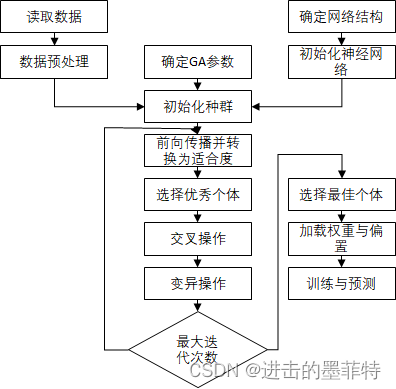
GA-BP神经网络——遗传算法优化BP神经网络Python实现
使用遗传算法(GA)优化BP神经网络。
文章目录
前言
善始者繁多,克终者盖寡。
先来回顾一下BP(Back Propagation)神经网络和遗传算法(Genetic Algorithm,GA)。
神经网络算法模仿了生理学上的神经网络,主要通过反向传播不断调整权重和偏置以减小误差(此时的误差就是损失函数),从而获取更准确的预测结果,在处理非线性问题和不确定性问题时具有良好的泛化能力,但是模型中初始参数会严重影响模型的性能,某些时候得到的结果往往不是全局最优。BP神经网络实例请看往期文章numpy手写BP神经网络。
遗传算法以达尔文进化理论为基础,是模拟生物进化过程以获取问题最优解的算法,涉及的操作主要有选择、交叉(繁衍)、变异,重要的概念有编码、个体、种群、适合度。该算法中通过选择操作挑选出优秀的个体,被选中的可能是依赖于个体适合度的高低,适合度高的个体被选中的可能性更大;通过交叉操作生成新的个体;通过变异操作扩大样本空间,增加随机性。 遗传算法实例请看往期文章GA遗传算法。
一、 遗传算法优化BP神经网络
1. 将神经网络中所有的权重、偏置组合为种群中的一个个体;
2. 将神经网络的实际输出与真实值间的误差作为GA的适合度函数;
3. 使用“优胜劣汰”替换BP神经网络中的反向传播过程;
4. 繁衍n代,从种群中挑选适合度最高的个体(个体就是权重和偏置的组合),相当于模型已经训练完毕,该个体就是模型最优时权重、偏置的值。
图解GA-BP神经网络:

请注意,此时种群中“个体”就是权重和偏置的连接形成的,在选择、交叉、变异操作中均有权重和偏置的更新操作!!!与BP神经网络中的反向传播对应,可以简单的理解为将反向传播操作替换为选择、交叉、变化操作。
二、代码实现
2.1 确定网络结构和GA参数
类中涉及BP神经网络的参数有num_inputs、num_hidden、num_outputs、learning_rate,分别表示神经网络的输入层、隐含层、输出层神经元个数以及神经网络的学习率。
涉及GA的参数有population 、population_size、fitness_values、mutation_rate ,分布表示种群本身、种群大小、种群中个体适合度的集合、变异概率。
此处种群优秀个体的依据是个体的适合度,所以后续会涉及大量的随机取值操作,于是在类中内置一个随机数生成器。
def __init__(self, num_inputs, num_hidden, num_outputs, population_size, mutation_rate, learning_rate):
self.num_inputs = num_inputs
self.num_hidden = num_hidden
self.num_outputs = num_outputs
self.learning_rate = learning_rate
self.population = []
self.population_size = population_size
#通过变异操作能够增大样本输入空间,类似于学习率,此处也以参数形式传入
self.mutation_rate = mutation_rate
#种群中各个体的适合度,fitness_values的大小与种群中个体数相同
self.fitness_values = np.zeros(population_size)
#后续操作中需要频繁使用随机取数的操作,所有在类中内置一个随机数生成器
self.random_state = check_random_state(None) # 设置随机数种子
2.2 初始化神经网络和种群
神经网络的初始参数通过numpy随机生成,此网络结构仅包含一个隐含层,所有权重只有input_hidden_weights、hidden_output_weights两个二维矩阵,将两个权重作为一个整体(通过元组的方式实现,因为相较于列表,元组内容不可变)加入种群中。
注意:虽然该网络结构只有两个权重,但实际运行时模型参数体量也是极其巨大的,受限于硬件条件,此处未添加偏置!!!
#初始化种群,也是初始化神经网络权重的过程,将某次随机生成的权重当做种群中的一个对象
def initialize_population(self):
# 短横杠表示临时参数,和占位符一个作用
for _ in range(self.population_size):
input_hidden_weights = np.random.uniform(low=-1, high=1, size=(self.num_inputs, self.num_hidden))
hidden_output_weights = np.random.uniform(low=-1, high=1, size=(self.num_hidden, self.num_outputs))
self.population.append((input_hidden_weights, hidden_output_weights))
2.3 前向传播并转换为适合度
种群中每一个个体都表示一组权重的组合,也就是一种方案,我们期望从中找出一种让模型效果最佳的方案,而判断某个方案优劣的依据是模型输出与真实数据间的误差,所以我们得先计算出每一种方案下模型的误差(这里用方差表示),该过程对应BP神经网络的前向传播过程。
某方案下模型的误差越小,说明该方案越好,放在种群中来说就是该个体适合度越高,我们很容易联想到用误差的倒数来表示种群中个体的适合度。
#适合度函数
def evaluate_fitness(self, x, y):
#计算中权重每个对象(权重)的适合度,并将适合度保存到fitness_values中
for i in range(self.population_size):
#此处为前向传播,计算中间层和输出层的激活值
input_hidden_weights, hidden_output_weights = self.population[i]
hidden_activations = self.sigmoid(np.dot(x, input_hidden_weights))
output_activations = np.dot(hidden_activations, hidden_output_weights)
#以方差作为损失函数,将损失函数的倒数作为适合度,损失函数越小,适合度函数值越大
error = np.mean((output_activations - y) ** 2)
self.fitness_values[i] = 1 / (error + 1e-8)
2.4 选择优秀个体
种群中所有个体的适合度计算出来后,我们就要挑选出优秀的个体以进行后续的繁衍行为,某个体被选择的几率取决于其适合度的高低,适合度高则被选择的几率大,此处用“个体适合度/总体适合度”表示某个体被选中的概率。
注意:有种观点是将个体按照适合度的高低进行排序,重复选择适合度较高的几个个体,本人对该观点存疑。
假设种群中有100个个体,在选择优秀个体时只重复选择适合度前10的个体组成新的种群,现适合度排名第十的个体A适合度为0.08,排名第十一的个体B适合度为0.79998,两者适合度相差无几,说不定经过变异操作B的适合度会高于个体A。
所有本人更倾向于用概率的方法来选择优秀个体。
def selection(self):
#计算总适合度,并将适合度转换为被选中的概率
total_fitness = np.sum(self.fitness_values)
selection_probs = self.fitness_values / total_fitness
#从种群中随机选择一些对象(依据概率),并将其保存到selected_population中
selected_indices = self.random_state.choice(np.arange(self.population_size), size=self.population_size, replace=True, p=selection_probs)
selected_population = []
for idx in selected_indices:
selected_population.append(self.population[idx])
self.population = selected_population
2.5 交叉操作
交叉操作是种群繁衍的主要操作,其思路是随机从种群中挑选两个个体,交换其部分信息以生成新的个体。而且,我们有理由让优秀的个体繁衍的可能性更大!!!
交叉操作二进制形式演示可参看GA遗传算法对应章节。
从代码角度看,具体操作是:
- 计算种群中各个体适合度;
- 使用类中随机数生成器选择父、母个体的下标,使用“p=selection_probs ”指定个体被选中的概率;
- 随机指定父、母个体交叉位置(此处个体表示的是input_hidden_weights、hidden_output_weights形成的元组,元组交叉类似于字符串拼接),生成新的个体;
- 用新的种群替换原来的种群。
#交叉(繁衍行为的主要操作)
def crossover(self):
offspring_population = []
# 计算总适合度,并将适合度转换为被选中的概率,因为我们有理由让适合度高的个体参与到繁衍的过程中
total_fitness = np.sum(self.fitness_values)
selection_probs = self.fitness_values / total_fitness
for _ in range(self.population_size):
#parent是input_hidden_weights、hidden_output_weights组合而成的元组
parent1_indices = self.random_state.choice(np.arange(self.population_size),p=selection_probs)
parent2_indices = self.random_state.choice(np.arange(self.population_size),p=selection_probs)
input_hidden_weights1, hidden_output_weights1 = self.population[parent1_indices]
input_hidden_weights2, hidden_output_weights2 = self.population[parent2_indices]
#对w1进行交叉操作,交叉点随机(把input1前半部分和Input2后半部分拼接)
crossover_point = self.random_state.randint(0, self.num_hidden)
input_hidden_weights = np.concatenate((input_hidden_weights1[:, :crossover_point], input_hidden_weights2[:, crossover_point:]), axis=1)
#对w2进行交叉操作,交叉点随机
crossover_point = self.random_state.randint(0, self.num_outputs)
hidden_output_weights = np.concatenate((hidden_output_weights1[:, :crossover_point], hidden_output_weights2[:, crossover_point:]), axis=1)
#将繁衍产生的对象放入新的种群,直至生成population_size个对象
offspring_population.append((input_hidden_weights, hidden_output_weights))
self.population = offspring_population
2.6 变异操作
变异操作增大了样本的输入空间,变异概率不宜过大,通常为1%~10%。具体代码实现就是在原有权重上整体添加一个较小的值,达到数据变化的效果。
此处变异操作与GA遗传算法中的具体实现有所不同。
#变异
def mutation(self):
for i in range(self.population_size):
input_hidden_weights, hidden_output_weights = self.population[i]
if self.random_state.rand() < self.mutation_rate:
input_hidden_weights += np.random.uniform(low=-0.1, high=0.1, size=(self.num_inputs, self.num_hidden))
if self.random_state.rand() < self.mutation_rate:
hidden_output_weights += np.random.uniform(low=-0.1, high=0.1, size=(self.num_hidden, self.num_outputs))
self.population[i] = (input_hidden_weights, hidden_output_weights)
2.7 训练模型
在BP神经网络中,理想情况是经过训练后的神经网络模型效果最佳,也就是经过训练后的神经网络模型权重、偏置等参数达到最优。
同样,GA-BP神经网络经过num_generations代繁衍后其输出也应当是所有个体中的最优个体,也可以说是所有方案中的最优方案,即最佳的input_hidden_weights和hidden_output_weights。
def train(self, x, y, num_generations):
self.initialize_population()
for generation in range(num_generations):
self.evaluate_fitness(x, y)
self.selection()
#挑选出优秀个体后重新计算种群中个体适合度,因为我们有理由让适合度高的个体参与到繁衍的过程中
self.evaluate_fitness(x, y)
self.crossover()
self.mutation()
best_weights = self.population[np.argmax(self.fitness_values)]
input_hidden_weights, hidden_output_weights = best_weights
return input_hidden_weights, hidden_output_weights
三、程序测试
3.1 问题描述与测试代码
使用GA-BP神经网络模型“异或”操作,测试程序中将模型保存为“.npy”格式的文件,目的是加快程序运行速度。
测试程序中创建了“2101”的网络结构,包含30个权重参数,种群中包含100个个体,繁衍一次需要更新30*100个参数,程序中共繁衍10000代,除去变异等操作,至少需要执行30 * 100 * 10000次操作,当神经网络神经元个数、网络层数、繁衍代数增加时,计算次数会更多。
if __name__ == '__main__':
# 设置神经网络和遗传算法参数
num_inputs = 2
num_hidden = 10
num_outputs = 1
population_size = 100
mutation_rate = 0.01
learning_rate = 0.1
num_generations = 10000
# 创建GA-BP神经网络对象
ga_bp = GeneticAlgorithmBP(num_inputs, num_hidden, num_outputs, population_size, mutation_rate, learning_rate)
# 创建训练数据集
x_train = np.array([[0, 0], [0, 1], [1, 0], [1, 1]])
y_train = np.array([[0], [1], [1], [0]])
#读取input_hidden_weights.npy文件
if os.path.exists('input_hidden_weights.npy'):
# 读取权重文件
input_hidden_weights = np.load('input_hidden_weights.npy')
hidden_output_weights = np.load('hidden_output_weights.npy')
else:
# 训练神经网络
input_hidden_weights, hidden_output_weights = ga_bp.train(x_train, y_train, num_generations)
#保存权重
np.save('input_hidden_weights.npy', input_hidden_weights)
np.save('hidden_output_weights.npy', hidden_output_weights)
# 使用训练好的权重进行预测
hidden_activations = ga_bp.sigmoid(np.dot(x_train, input_hidden_weights))
output_activations = np.dot(hidden_activations, hidden_output_weights)
# predictions = np.round(output_activations)
predictions = output_activations
print("预测结果:")
print(predictions)
3.2 测试结果
预测误差较小,已经十分接近真实结果了。

四、完整代码
import numpy as np
from sklearn.utils import check_random_state
import os
class GeneticAlgorithmBP:
def __init__(self, num_inputs, num_hidden, num_outputs, population_size, mutation_rate, learning_rate):
self.num_inputs = num_inputs
self.num_hidden = num_hidden
self.num_outputs = num_outputs
self.learning_rate = learning_rate
self.population = []
self.population_size = population_size
#通过变异操作能够增大样本输入空间,类似于学习率,此处也以参数形式传入
self.mutation_rate = mutation_rate
#种群中各个体的适合度,fitness_values的大小与种群中个体数相同
self.fitness_values = np.zeros(population_size)
#后续操作中需要频繁使用随机取数的操作,所有在类中内置一个随机数生成器
self.random_state = check_random_state(None) # 设置随机数种子
def sigmoid(self, x):
return 1 / (1 + np.exp(-x))
#初始化种群,也是初始化神经网络权重的过程,将某次随机生成的权重当做种群中的一个对象
def initialize_population(self):
# 短横杠表示临时参数,和占位符一个作用
for _ in range(self.population_size):
input_hidden_weights = np.random.uniform(low=-1, high=1, size=(self.num_inputs, self.num_hidden))
hidden_output_weights = np.random.uniform(low=-1, high=1, size=(self.num_hidden, self.num_outputs))
self.population.append((input_hidden_weights, hidden_output_weights))
#适合度函数
def evaluate_fitness(self, x, y):
#计算中权重每个对象(权重)的适合度,并将适合度保存到fitness_values中
for i in range(self.population_size):
#此处为前向传播,计算中间层和输出层的激活值
input_hidden_weights, hidden_output_weights = self.population[i]
hidden_activations = self.sigmoid(np.dot(x, input_hidden_weights))
output_activations = np.dot(hidden_activations, hidden_output_weights)
#以方差作为损失函数,将损失函数的倒数作为适合度,损失函数越小,适合度函数值越大
error = np.mean((output_activations - y) ** 2)
self.fitness_values[i] = 1 / (error + 1e-8)
def selection(self):
#计算总适合度,并将适合度转换为被选中的概率
total_fitness = np.sum(self.fitness_values)
selection_probs = self.fitness_values / total_fitness
#从种群中随机选择一些对象(依据概率),并将其保存到selected_population中
selected_indices = self.random_state.choice(np.arange(self.population_size), size=self.population_size, replace=True, p=selection_probs)
selected_population = []
for idx in selected_indices:
selected_population.append(self.population[idx])
self.population = selected_population
#交叉(繁衍行为的主要操作)
def crossover(self):
offspring_population = []
# 计算总适合度,并将适合度转换为被选中的概率,因为我们有理由让适合度高的个体参与到繁衍的过程中
total_fitness = np.sum(self.fitness_values)
selection_probs = self.fitness_values / total_fitness
for _ in range(self.population_size):
#parent是input_hidden_weights、hidden_output_weights组合而成的元组
parent1_indices = self.random_state.choice(np.arange(self.population_size),p=selection_probs)
parent2_indices = self.random_state.choice(np.arange(self.population_size),p=selection_probs)
input_hidden_weights1, hidden_output_weights1 = self.population[parent1_indices]
input_hidden_weights2, hidden_output_weights2 = self.population[parent2_indices]
#对w1进行交叉操作,交叉点随机(把input1前半部分和Input2后半部分拼接)
crossover_point = self.random_state.randint(0, self.num_hidden)
input_hidden_weights = np.concatenate((input_hidden_weights1[:, :crossover_point], input_hidden_weights2[:, crossover_point:]), axis=1)
#对w2进行交叉操作,交叉点随机
crossover_point = self.random_state.randint(0, self.num_outputs)
hidden_output_weights = np.concatenate((hidden_output_weights1[:, :crossover_point], hidden_output_weights2[:, crossover_point:]), axis=1)
#将繁衍产生的对象放入新的种群,直至生成population_size个对象
offspring_population.append((input_hidden_weights, hidden_output_weights))
self.population = offspring_population
#变异
def mutation(self):
for i in range(self.population_size):
input_hidden_weights, hidden_output_weights = self.population[i]
if self.random_state.rand() < self.mutation_rate:
input_hidden_weights += np.random.uniform(low=-0.1, high=0.1, size=(self.num_inputs, self.num_hidden))
if self.random_state.rand() < self.mutation_rate:
hidden_output_weights += np.random.uniform(low=-0.1, high=0.1, size=(self.num_hidden, self.num_outputs))
self.population[i] = (input_hidden_weights, hidden_output_weights)
def train(self, x, y, num_generations):
self.initialize_population()
for generation in range(num_generations):
self.evaluate_fitness(x, y)
self.selection()
#挑选出优秀个体后重新计算种群中个体适合度,因为我们有理由让适合度高的个体参与到繁衍的过程中
self.evaluate_fitness(x, y)
self.crossover()
self.mutation()
best_weights = self.population[np.argmax(self.fitness_values)]
input_hidden_weights, hidden_output_weights = best_weights
return input_hidden_weights, hidden_output_weights
if __name__ == '__main__':
# 设置神经网络和遗传算法参数
num_inputs = 2
num_hidden = 10
num_outputs = 1
population_size = 100
mutation_rate = 0.01
learning_rate = 0.1
num_generations = 10000
# 创建GA-BP神经网络对象
ga_bp = GeneticAlgorithmBP(num_inputs, num_hidden, num_outputs, population_size, mutation_rate, learning_rate)
# 创建训练数据集
x_train = np.array([[0, 0], [0, 1], [1, 0], [1, 1]])
y_train = np.array([[0], [1], [1], [0]])
#读取input_hidden_weights.npy文件
if os.path.exists('input_hidden_weights.npy'):
# 读取权重文件
input_hidden_weights = np.load('input_hidden_weights.npy')
hidden_output_weights = np.load('hidden_output_weights.npy')
else:
# 训练神经网络
input_hidden_weights, hidden_output_weights = ga_bp.train(x_train, y_train, num_generations)
#保存权重
np.save('input_hidden_weights.npy', input_hidden_weights)
np.save('hidden_output_weights.npy', hidden_output_weights)
# 使用训练好的权重进行预测
hidden_activations = ga_bp.sigmoid(np.dot(x_train, input_hidden_weights))
output_activations = np.dot(hidden_activations, hidden_output_weights)
# predictions = np.round(output_activations)
predictions = output_activations
print("预测结果:")
print(predictions)

开放原子开发者工作坊旨在鼓励更多人参与开源活动,与志同道合的开发者们相互交流开发经验、分享开发心得、获取前沿技术趋势。工作坊有多种形式的开发者活动,如meetup、训练营等,主打技术交流,干货满满,真诚地邀请各位开发者共同参与!
更多推荐
 已为社区贡献5条内容
已为社区贡献5条内容





所有评论(0)